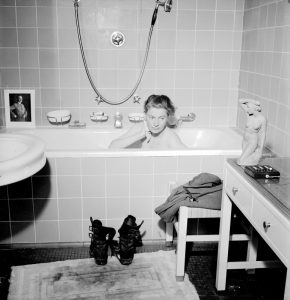
A beautiful poem of resistance!
Liberty By Paul Éluard
On my school notebooks
On my desk and on the trees
On the sand, on the snow
I write your name [Liberty]
On all the pages read
On all the blank pages
Stone, blood, paper, or ash
I write your name [Liberty]
On the golden images
On the weapons of warriors
On the crown of kings
I write your name [Liberty]
On the jungle and the desert
On the nests, on the broom
On the echo of my childhood
I write your name [Liberty]
On the marvels of nights
On the white bread of days
On the betrothed seasons
I write your name [Liberty]
Who was Lee Miller?
Lee Miller (1907–1977) was a unique and trailblazing figure of the 20th century: muse, artist, war correspondent, and a fiercely independent woman in a world that was anything but. Born in the United States, she began her career as a model in 1920s New York before becoming the protégée (and sometimes partner) of major artists like Man Ray in Paris. She quickly broke free from her role as muse to assert herself as a surrealist photographer in her own right.
During World War II, she became a war correspondent for Vogue, covering key moments on the European front: the liberation of Paris, the concentration camps, and the battle of Saint-Malo. One of the most iconic and provocative images in history shows her in Hitler’s private bathtub, in his Munich apartment, taken shortly after the fall of the Third Reich.
A complex, bold woman constantly pushing against societal and gender norms, Lee Miller left a powerful legacy in photography, journalism, and women’s liberation. Her work, long overshadowed, is now recognized as essential.
But what about her connection to Paul Éluard?
While Lee Miller and Paul Éluard were not direct collaborators, they moved within the same surrealist circles in 1930s Paris — among artists like Man Ray, Max Ernst, Salvador Dalí, and André Breton. A famous photo taken by Miller shows Éluard with his partner Nusch, both deeply involved in the surrealist movement. This image reflects the artistic and philosophical proximity they shared.
Éluard’s politically charged poetry and Miller’s striking photography both explored injustice, absurdity, and the transformative power of art. Each, in their own medium, used art as acts of poetic resistance in a fractured, war-torn world.
Who was Paul Éluard?
And who was David E. Scherman?

David E. Scherman (1916–1997) was a renowned American photographer, best known for his work as a World War II correspondent for Life magazine. Born in New York, he joined Life in 1936 and quickly rose to prominence in the world of American photojournalism.
He is most closely associated with Lee Miller, forming an unforgettable duo on the European front. Together, they covered major events of the war: the liberation of Paris, the discovery of the Dachau and Buchenwald concentration camps, and the fall of Nazi Germany.
Scherman is perhaps most famously remembered for the iconic photograph of Lee Miller in Hitler’s bathtub in Munich, taken shortly after the fall of the Third Reich. That image — bold, irreverent, and unforgettable — became a symbol of defiance against Nazi power and a quiet moral triumph for the silenced.
After the war, Scherman continued his work with Life and later turned to writing and editing. His keen eye and deep sense of humanity left a lasting imprint on the history of visual journalism.


